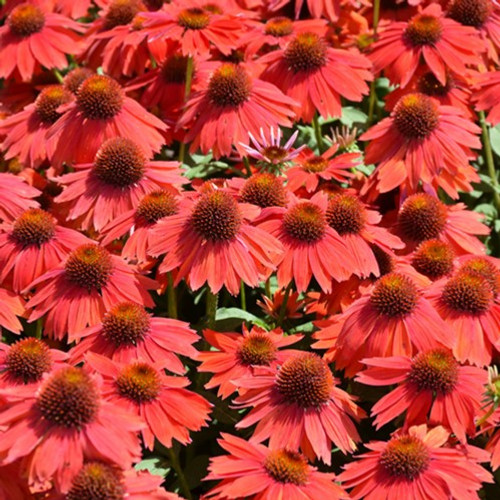| Echinacea purpurea | USDA Zone: 3-8 |
Purple Coneflower has masses of beautiful lightly-scented purple daisy flowers with coppery-bronze eyes at the ends of the stems from mid summer to early fall, which are most effective when planted in groupings. The flowers are excellent for cutting. Its pointy leaves remain green in colour throughout the season.
This elegant echinacea produces large purple flowers with coppery centers; a perfect choice for planting in groups, along border edges, or in containers; great for flower arrangements, attracts pollinators.
Purple Coneflower is recommended for the following landscape applications;
- Mass Planting
- General Garden Use
- Container Planting
Bloom Time: Summer, Fall
Native to Ontario
Common name: Purple Coneflowe, Eastern Purple Coneflower
|
Key Feature
|
Light Needs | Landscape Uses |
 |
 |
|
|
|
|
| More About Purple Coneflower |
| Height: 36 inches |
Spread: 18-24 inches |
Flower Colour: Purple / Pink Shades |
|
Purple Coneflower should only be grown in full sunlight. It is very adaptable to both dry and moist locations, and should do just fine under typical garden conditions. It is considered to be drought-tolerant, and thus makes an ideal choice for a low-water garden or xeriscape application. It is not particular as to soil type or pH. It is highly tolerant of urban pollution and will even thrive in inner city environments. Praised for their large, daisy-like flowers which appear from midsummer thru fall, after many other perennials have finished blooming, Coneflowers are a mainstay in today's garden. If deadheaded, the bloom cycle will be extended. However, some spent blooms should be left on the plants in fall because their seeds provide winter food for finches and other birds. The dried seed heads also provide architectural interest in the winter. Purple Coneflower is a fine choice for the garden, but it is also a good selection for planting in outdoor pots and containers. With its upright habit of growth, it is best suited for use as a 'thriller' in the 'spiller-thriller-filler' container combination; plant it near the center of the pot, surrounded by smaller plants and those that spill over the edges. It is even sizeable enough that it can be grown alone in a suitable container. Note that when grown in a container, it may not perform exactly as indicated on the tag - this is to be expected. Also note that when growing plants in outdoor containers and baskets, they may require more frequent waterings than they would in the yard or garden. Be aware that in our climate, most plants cannot be expected to survive the winter if left in containers outdoors, and this plant is no exception. NOTE: Some flowers and plants may be harmful or poisonous to people or pets if touched or ingested. If you require more information before placing an order, please let us know in advance. |










